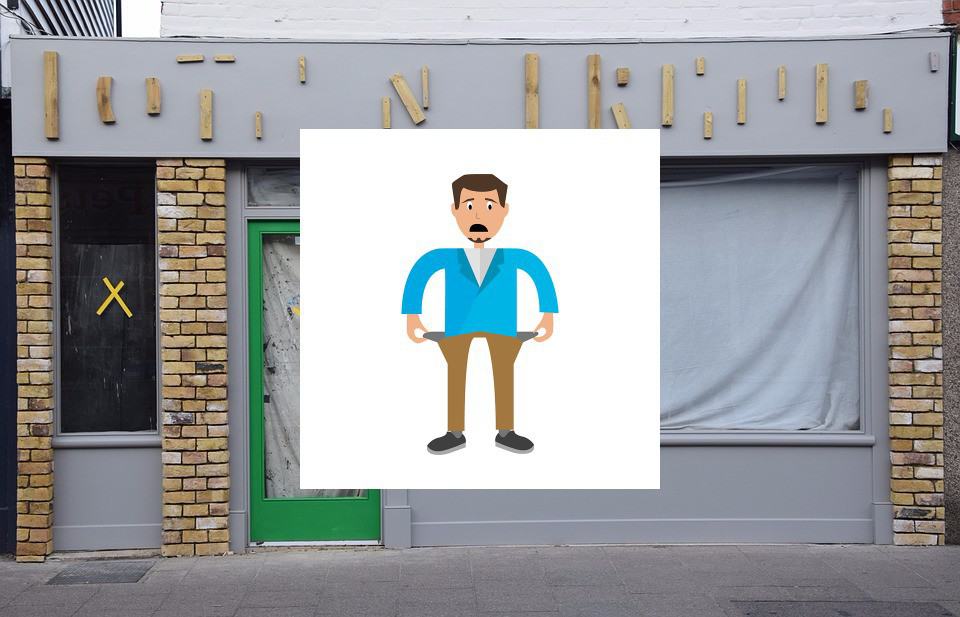If you would prefer to listen to the audio version of this Brandon’s Blog, please scroll to the bottom and click on the podcast
Bankrupting a corporation: Introduction
I have blogged on personal and corporate insolvency matters for just over 6 years now. I have covered many topics. During a recent corporate bankruptcy consultation, I realized that I have never written about what the steps are for bankrupting a corporation. An important issue arising from this topic would be what the Directors of a corporation going into bankruptcy should know.
There are 3 ways for a company to be bankrupt
Like in all bankruptcy matters, there are three methods that result in bankrupting a corporation in Canada. The first way is being pushed, and the second way is jumping in with both feet voluntarily (I know, corporations don’t have feet!). The third way is to have the company’s creditors vote down a corporation’s attempt to restructure under a Proposal under the Bankruptcy and Insolvency Act (Canada) (BIA). In this Brandon’s Blog, I will focus on describing the first two methods.
Bankruptcy application – an involuntary bankruptcy
Being pushed means that one or more unsecured creditors, owed in total at least $1,000, has made a motion before the Court asking that a Bankruptcy Order be made against the company. The motion is called a Bankruptcy Application.
In order to do so, the unsecured creditor(s) have to:
- retain a bankruptcy lawyer.
- gotten the consent of a licensed insolvency trustee (formerly called a bankruptcy trustee) (Trustee) to administer the corporate bankruptcy.
- In addition to proving the debt owing, the applicant(s) also have to prove that at least one act of bankruptcy was committed by the company within the 6 months before the filing of the bankruptcy application.
There are various acts of bankruptcy listed in Section 42(1) of the BIA. Commonly seen acts of bankruptcy are fraudulent transfers of property, allowing a lawful seizure of some or all of their property by a creditor under a lawful process, and the catch-all ceasing to meet many liabilities as they come due.
Jumping in with both feet – a voluntary bankruptcy
By this term, I mean filing an Assignment in Bankruptcy. In this case, rather than someone going to Court, the Directors call a Directors’ meeting. At the meeting, the Directors resolve that the company is experiencing financial difficulty and cannot continue to run. The Directors also reserve that the company should file an assignment in bankruptcy and it gives authority to one Director to sign all the necessary documents.
The Director who has the authority to sign the bankruptcy documents is called the Designated Officer. Before the documents are ready for signing, the Trustee who is selected must get enough information to prepare the documentation.
Whether bankrupting a corporation in Ontario or elsewhere in Canada and regardless if it is a result of a Bankruptcy Order or an Assignment in Bankruptcy, the information the Trustee requires is the same.
Information and documents a Trustee needs
The Trustee requires a great deal of information before being able to properly administer a voluntary or involuntary corporate bankruptcy. Sometimes company officials can provide it and in other cases, the Trustee has to dig through the books and records of the company.
Here is the lengthy list of what is needed:
- Exact corporate name and address of head office, details of any other locations, copy of any premises leases.
- Minute book and corporate seal.
- Bankruptcy Order or the resolution of the Directors.
- Full description of the nature of the business.
- Names of Officers and Directors and their addresses.
- Date of incorporation of the company.
- The date the company ceased operations, if prior to the date of bankruptcy.
- The greatest number of employees employed in the last 12 months.
- All employees – listing of names, addresses, social insurance number, amounts owing for each of severance, termination, wages, vacation pay, commissions and expenses.
- Employee T4’s & ROE’s for current year employees (employer should issue to all employees for the year of bankruptcy and earlier if unissued).
- Creditors’ listing (accounts payable) – details consisting of name, address, account number(s), and respective amounts owing classified as follows:
- Secured – banks, leasing company, source deductions, etc.
- Preferred – wages owing, rent to landlords, government remittances outstanding:
- Workers Compensation Board, if applicable.
- Municipal authorities: e.g. business taxes and realty taxes.
- Employer’s health tax.
- Unsecured – trade suppliers; Hydro; Bell Canada (quote telephone number(s); gas, etc.
- Details of any unsecured private party loans, shareholder loans or advances due to the company.
- Details of any unions, if applicable, including name, address, account number.
- Details of contingent liabilities and pending legal action, if any.
- Accounts receivable – aged trial balance and detailed backup documentation (invoices, delivery slips, purchase orders, etc.) to support collection efforts. From the aged trial balance, classify the accounts as good, doubtful, bad to equal the total balance.
- Inventory – detailed information on inventory cost and the company’s assessment of estimated realizable values.
- Machinery, equipment and plant – detailed listing providing original cost, if possible and estimated realizable value.
- Office furniture & fixtures – detailed listing providing original cost, if possible and estimated realizable value.
- Real estate – all details of real estate owned, including deeds, legal descriptions, original costs, appraisals (if any), an estimated fair market value.
- Vehicles – provide descriptions including year, model, VIN, kilometres, original costs and estimated realizable value. Note if any vehicles are leased/financed and provide copies of the lease/finance documentation.
- Other assets – details of other assets such as prepaid expenses, deposits, goodwill, intangibles, shares or any investments, patents, trademarks.
- Bank accounts – details of all bank accounts, including name, address, account number and approximate balance in the accounts.
- Last 12 months of accounting records, bank statements and cancelled cheques (for all accounts maintained).
- Financial statements – most recent.
- Corporate solicitor – name and address.
- Listing of leased equipment (copy of leases) – vehicles, office and any other equipment.
- Insurance policy(ies).
- A brief narrative of management’s opinion as to cause(s) of insolvency.
- Disclosure of any sale or disposition of assets, outside of the ordinary course of business, in the last year.
The Trustee’s job
In a corporate bankruptcy, the Trustee, with certain exceptions, takes possession of the assets of the company. If the Trustee is aware that there are deemed trust claims against the assets, or there is a secured creditor, like a Chartered Bank, the Trustee must be careful. If there are, the Trustee should have already had a conversation with those parties prior to the bankruptcy, to decide what rights, if any, the Trustee may have against such property.
Assuming there are assets not subject to the valid claim of third parties, the Trustee must at least:
- Establish whether the value of the assets will be enhanced if the Trustee operates the company’s business.
- Take into account what obstacles exist in running the business and how to reduce risk if it is beneficial or necessary to run the business.
- Decide what are the very best means to sell the properties? En bloc as one parcel or individually or at least several parcels?
- Determine if there are any 3rd party owned assets on the company’s premises?
- Identify if there are any company assets on the property of 3rd parties?
- Prepare the required reporting to Service Canada so that the former employees will be able to make their Wage Earner Protection Plan Act claims.
- See if there are proper insurance coverage and proper physical security over the assets?
- Identify any inventory been delivered in the 30 days prior to the date of bankruptcy? What rights of revindication might exist?
- Circularize the creditors requesting claims to be filed to understand what the depth and breadth of claims against the company are. This way, the Trustee can formulate a distribution to creditors, in priority, with the net funds available from the sale of assets.
What the Directors should be concerned about
Directors should have two concerns when contemplating bankrupting a corporation. First, they should be concerned about any decisions they have made or senior management actions they have ratified.
For example, Sears in the United States recently lodged a claim versus its previous CEO Eddie Lampert and a string of its top-level previous Directors. This includes Eddie Lampert’s previous Yale roomie Treasury Secretary Steven Mnuchin. The allegation is that the Directors condoned and approved Eddie Lampert’s actions for presumably swiping billions of dollars from the once-storied merchant.
Second, there are various types of claims against the corporation that are also personal claims against Directors. The list includes Director liability for unpaid:
- Wages
- HST
- Source deductions
- Certain environmental offences
- Cybersecurity risks
In general, there is a relatively short list of things Directors can be personally liable for. In many cases, there will be Director and Officer Insurance to be relied upon. Directors may also have a due diligence defence.
A Director resigning their position will not protect them against any liability that would be a personal Director liability prior to their resignation.
Are you a Corporate Director?
Are you a Director of a corporation that has too much debt? Is your company’s capital insufficient to fulfill every one of its economic responsibilities and may be insolvent? Are you worried that your firm’s major secured lender will soon pull its financing completely and demand repayment in full which the company will not be able to do?
If you responded yes to any of these questions, call the Ira Smith Team today so we can kill off the stress and anxiety that these financial troubles have activated. We will create a strategy for the Directors unique for your company’s problems so that it can avoid bankruptcy and become profitable and continue to employ many people.
Call the Ira Smith Team today. We have decades and generations of experience restructuring and turning around companies seeking financial restructuring or a debt negotiation strategy. As a licensed insolvency trustee, we are the only specialists recognized, certified and monitored by the federal government to offer insolvency guidance to save businesses.
You can have a no-cost assessment so we can fix your company’s debt problems. Call the Ira Smith Team today. This will absolutely allow you to return to being efficient, healthy and balanced, Starting Over Starting Now.
[monkeytools msnip=”http://monkeyplayr.com/playr.php?u=5173&p=20719″]



